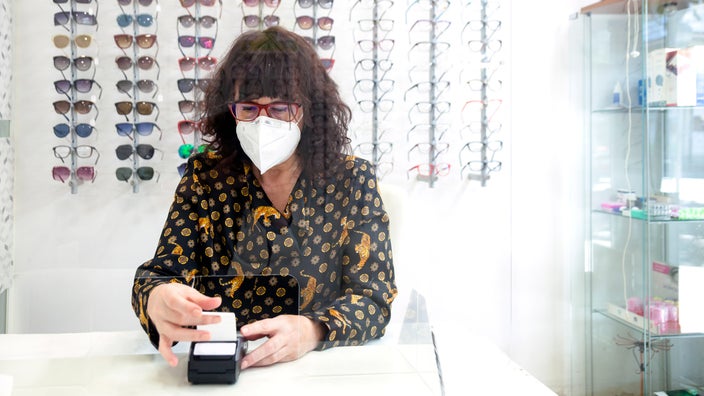
Can You Use an HSA and FSA for Vision Expenses? Eligibility of 54 Common Eye Care Items
Key takeaways:
Health savings accounts (HSAs) and flexible spending accounts (FSAs) provide tax advantages that can help you pay for common vision and eye care costs your insurance may not cover.
Eligible vision expenses include eye exams, prescription glasses, and contact lenses.
You should confirm qualified vision expenses with your FSA or HSA plan administrator to avoid unexpected taxes and penalties.
Table of contents

Health savings accounts (HSA) and flexible spending accounts (FSAs) are tax-exempt accounts used to offset the cost of healthcare. Every penny that goes into an HSA or FSA can pay for eligible expenses, tax-free. One category of eligible expenses that is often overlooked is vision care.
Common vision care expenses like annual eye exams, prescription eyeglasses, and contact lenses are typically covered by vision insurance. But you’ll have to pay out of pocket for any expenses that your vision plan doesn’t cover. You can save money by using your HSA or FSA to cover costs that are not reimbursed by your employer or insurance plan.
Below is a list of 54 vision and eye care items that are FSA or HSA eligible, so you can start saving money today.
Prescription Savings Are Just the Beginning
See what other benefits you qualify for—from cashback cards to cheaper insurance.

Can I use my HSA or FSA for vision care?
Yes. Your HSA or FSA can cover many healthcare expenses, including vision and eye care items. Before you make a purchase, however, you should review the list of eligible vision care items provided by your HSA/FSA plan administrator.
Your HSA and FSA vision care coverage is not limited to purchases you make for yourself, either. You can also use your accounts to pay for vision expenses for your spouse and eligible dependents — even if they are covered under a different insurance plan.
Before you sign up for an FSA or HSA to cover your vision care, you should weigh the pros and cons of both accounts. You must have a qualified high-deductible health plan to contribute to an HSA. No other health insurance plans will qualify you for it.
You can sign up for an HSA through your employer (if offered) or open an account on your own at a financial institution. This account allows you to contribute pretax dollars and invest your money tax-free. All the money remaining in your HSA at the end of the year can roll over to the next year. When you are ready to withdraw funds for eligible vision expenses, you can spend the money without paying any taxes.
FSAs don’t offer as much flexibility as HSAs because of their “use-it-or-lose-it” feature. FSA plan participants will lose all unused money in their account if they don’t use it by the end of the plan year. But your employer may give you extra time to use all or some of the money in your account through a grace period or carryover option. It’s important to plan ahead and identify eligible expenses you can spend your FSA dollars on before the deadline.
Common vision and eye care items eligible under HSA/FSA rules
There are many vision and eye care items that qualify as medical expenses. Generally, an expense must correct a vision problem or treat a specific condition to be FSA or HSA eligible.
Read more like this
Explore these related articles, suggested for readers like you.
Prescription contact lenses and eyeglasses are common FSA/HSA-eligible vision expenses, but here are a few more that may qualify:
Astigmatic keratotomy (AK) surgery
Automated lamellar keratoplasty (ALK) surgery
Bifocals
Contact cleaning solution
Contact lens cases
Corrective swim goggles
Enzyme cleaner for contact lenses
Epi-Lasik surgery
Eye allergy itch relief
Eye care copays
Eye care deductibles
Eye charts
Eye drops
Eye exams
Eyeglass case
Eyeglass cleaning cloth
Eyeglass repair
Eyeglass repair kit
Folding cane for blind or visually impaired people
Intacs surgery
LASEK (laser epithelial keratomileusis) surgery
LASIK (laser in-situ keratomileusis) surgery
Lens cleaning tissue
Phakic intraocular lens implants
Photorefractive keratectomy (PKR)
Pre-moistened eyeglass lens wipes
Presbyopic lens exchange (PRELEX)
Prescription designer glasses
Prescription safety glasses
Prescription safety goggles
Prescription scuba masks
Progressive multifocals
Reading glasses
Refractive lens exchange (RLE)
Rewetting drops
Saline solution
Sports masks with prescription lenses
Therapy eye mask
Tinted reading glasses
Vision shaping treatment
If you are blind or visually impaired, here are five more qualified expenses if you have a guide dog:
Buying a guide dog to assist with daily movement
Purchasing food for the dog
Grooming the dog
Training a guide dog
Taking the dog to vet visits
Your FSA or HSA can also cover travel expenses for procedures needed to treat an eye condition. The services must be performed by a qualified optometrist or ophthalmologist. Common types of covered travel expenses include:
Bus ticket
Gasoline
Parking
Ride-share service
Taxi
Tolls
Train ticket
Contact your HSA/FSA administrator to confirm which vision products are eligible expenses. If you need eye care services, you should work with a qualified optometrist or ophthalmologist. All vision and eye care items must be deemed medically necessary to qualify as an FSA- or HSA-eligible expense.
Some items, like blue-light glasses, may be FSA or HSA eligible if your plan administrator allows it. However, you may need a letter of medical necessity to get this expense approved.
Using an HSA or FSA for glasses
Vision insurance may cover all or a portion of the costs for glasses. The benefits may be limited to a certain dollar amount for glasses or contact lenses per year. Instead of covering additional costs on your own, you can use your HSA or FSA to cover the expense.
If you have a prescription from your doctor, you can use your FSA or HSA to cover many types of prescription glasses, including:
Bifocal lenses
Blue-light glasses
Progressive lenses
Safety goggles
Single-vision glasses
Sports masks
Sunglasses
You can even use your account to cover prescription designer glasses. The glasses must be used to correct vision problems to be eligible for reimbursement under an FSA.
You don’t need a prescription to purchase reading glasses with your FSA or HSA. You can purchase these glasses online or in store at an FSA-approved retailer.
Using an HSA or FSA for contact lenses
The IRS considers prescription contact lenses a qualified medical expense. So you can use pretax funds in your HSA or FSA to cover the cost of your contact lenses and any items required for proper care and maintenance of lenses. This includes contact lens cases, enzyme cleaner, and saline solution.
If you buy contact lenses solely for cosmetic purposes, however, the expense is not eligible. You are not allowed to use your HSA or FSA for colored contact lenses unless your doctor gives you a prescription.
Using an HSA or FSA for LASIK
LASIK (laser-assisted in situ keratomileusis) is a popular type of vision correction procedure. If you are nearsighted, farsighted, or have astigmatism, your doctor can let you know if LASIK is an option for you. This eye surgery can replace or reduce your need for prescription contact lenses and eyeglasses.
The surgery can cost an average of $4,000 to $5,000 for both eyes. Medicare, Medicaid, and traditional health insurance plans may not cover it unless it’s medically necessary.
The IRS considers laser eye surgery that’s used to correct defective vision a qualified medical expense. That means you can use your HSA or FSA to pay for LASIK. Due to the annual FSA contribution limits and rules, you may not have enough money in your FSA to cover LASIK. Since your HSA allows you to roll over unused funds every year, you may have more flexibility to use this account to save for LASIK.
What vision expenses are NOT covered by an HSA or FSA?
Vision expenses that are reimbursed by your insurance plan or employer are not FSA or HSA eligible. The IRS also does not allow your accounts to be used for cosmetic or general health purposes.
Here are a few expenses that are not covered:
Costume contact lenses
Extended warranties for glasses
Non-corrective blue-light glasses
Nonprescription colored contact lenses
Nonprescription fashion glasses
Nonprescription sunglasses
Premiums for contact lens replacement services
Safety glasses
If you use your HSA to cover a nonqualified expense, you could be on the hook for taxes and penalties. It all depends on your age. If you’re age 65 and over, you can withdraw money from your HSA for any type of expense without paying a penalty. You’ll just have to pay taxes on your distribution. But if you haven’t reached 65 yet, you’ll most likely have to pay a 20% penalty when you use your HSA to pay for an ineligible expense.
Will I need to provide a letter of medical necessity for my vision items?
A letter of medical necessity (LOMN) is not required for most vision expenses. An LOMN is a note from a doctor detailing what specific condition you have and recommendations for treatment. Your HSA or FSA plan administrator may request an LOMN for expenses like a Theragun or water flosser.
You should always check with your HSA/FSA plan administrator to confirm if an expense qualifies. The IRS also provides a list of qualified medical, dental, and vision expenses.
How to use your HSA or FSA to purchase vision care
If you want to use your pre-tax dollars for vision care, here are some steps you can take:
Confirm which vision care expenses are HSA/FSA eligible. If you have a list of vision care products or services that you want to purchase during the year, reach out to your HSA/FSA provider to confirm if they are eligible for tax-free withdrawals.
Monitor your account balance. Review your account balance frequently to ensure you maximize your HSA/FSA account. If you have an FSA, there is a deadline to use the funds in your account. Plan your expenses during the year to make the most of your FSA dollars.
Use your HSA/FSA debit card. If your account provider issued a debit card for your HSA/FSA, you can use it at your optometrist/ophthalmologist office. You can also use it in-store or online as long as the retailer accepts FSA/HSA debit cards.
Keep your receipts. You will need your receipt to get reimbursement from your FSA if you pay out of pocket. You’ll also need your receipts to prove HSA- and FSA-eligible expenses in case your account administrator requests documentation or if you are ever subject to an IRS audit.
The bottom line
Your FSA or HSA can cover vision and eye care items. These accounts provide you with tax benefits that can lower your cost on common expenses like prescription contact lenses, saline solution, and cases.
If you use your FSA or HSA to pay for nonqualified vision expenses, you may be subject to taxes and penalties. Before making a purchase, determine if your expense is an eligible FSA/HSA item and if any documentation is needed to verify your purchase.
Why trust our experts?

References
Internal Revenue Service. (2024). About Publication 502, medical and dental expenses.
Mayo Clinic (2023). LASIK eye surgery.
Vision Center. (2024). LASIK surgery cost.
This article is solely for informational purposes. This article is not professional advice concerning insurance, financial, accounting, tax, or legal matters. All content herein is provided “as is” without any representations or warranties, express or implied. Always consult an appropriate professional when you have specific questions about any insurance, financial, or legal matter.




























